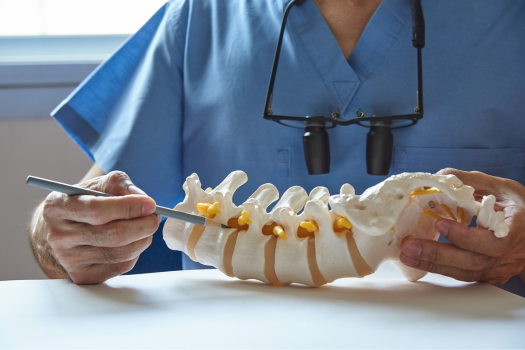
Lumbar discectomy is a surgical procedure that involves removing part of a herniated disc in the lower back. A herniated disc occurs when the soft inner material of the disc bulges out through a tear in the outer layer, causing pressure on the spinal nerves. This can result in pain, numbness, tingling, or weakness in the lower back and legs. This article explains the reasons lumbar discectomy may be recommended as well as the diagnostic procedures and surgical techniques involved with this type of back surgery.
Why Is Lumbar Discectomy Performed?
Lumbar discectomy is performed to relieve the symptoms caused by a herniated disc that does not respond to conservative treatments, such as medication, physical therapy, or injections. The goal of this type of herniated disc surgery is to remove the part of the disc that is compressing the nerve root and restore normal function and mobility.
The symptoms of a herniated lumbar disc can vary depending on the location and severity of the condition. Common symptoms include lower back pain, radiating pain down the legs (sciatica), numbness, tingling, muscle weakness, and difficulty walking or standing. These symptoms often worsen with certain movements, such as bending, lifting, or sitting for prolonged periods. If these symptoms persist or significantly affect daily activities, it is essential to consult a healthcare professional for a proper diagnosis.
How Is a Herniated Lumbar Disc Diagnosed?
To diagnose lumbar disc herniation, healthcare professionals employ various diagnostic procedures. The initial step usually involves a comprehensive physical examination during which the doctor assesses reflexes, muscle strength, and sensory responses. Imaging tests, such as X-rays, magnetic resonance imaging (MRI), or computed tomography (CT) scans, may be ordered to visualize the spine and identify the exact location and severity of the herniation. These diagnostic procedures help doctors determine the suitability of lumbar discectomy as a treatment option.
How Is Lumbar Discectomy Performed?
What Are the Risks and Complications of Lumbar Discectomy?
- Lumbar discectomy is generally a safe and effective procedure, but, as with any surgery, there are some risks and complications that may occur. These include:
- Bleeding
- Infection
- Nerve damage
- Spinal fluid leak
- Recurrence of herniation
- Chronic pain
- Spinal instability
What Is the Recovery Process After Lumbar Discectomy?
- Stay in the hospital for one or two days
- Wear a brace or corset for a few weeks
- Avoid bending, twisting, or lifting heavy objects for six weeks
- Resume normal activities gradually as tolerated
- Participate in physical therapy to strengthen the back muscles and increase flexibility
For full benefit/risk information, please visit: https://www.barricaid.com/instructions.


Comments